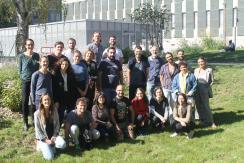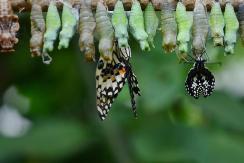COEVOL Multi-Scale Coevolution
Living systems are highly integrated, with a multitude of levels of organization, from molecular and intra-cellular scales to ecosystems. Complex organisms are themselves consortia of macro- and micro-organisms, which work together with their host to build the individual. Yet, each of these organisms can function and evolve in the short term according to its own logic, possibly in conflict with other higher or lower levels, or with other time scales. The once common idea among evolutionists that natural selection results in organisms perfectly adapted to their environment is now severely undermined. Not only because, as the Red Queen explains to Alice, one has to run relentlessly to keep its place in a changing environment, or because past evolutionary history and chance constrain the possibilities of present adaptation, but also because different levels of selection have interests that are generally difficult to reconcile.
Multi-scale coevolution resets classical questions in evolutionary biology
One example, of particular interest is the question of the source of heritable variations. The phenotype of organisms in a population is influenced not only by variations in their nuclear and mitochondrial genomes, the dynamics of which is the object of population genetics, but also more and more patently by the consortium of microbes and genetic elements that constitute its microbiome and virome. The hologenome designates this complex assembly of genetic materials, which obey different rules of transmission and different evolutionary strategies. The ability of symbionts to manipulate host phenotypes or to interfere with each other influences the evolutionary dynamics of all players in ways that are yet poorly understood. In addition, new questions arise, such as the importance of co-adaptation in these systems and their consequences in maintaining cohesive biological systems.
- Symbiosis: a response to and a source of divergent selection
Using a variety of approaches combining experimental evolution, genomic, functional, phenotypic and behavioral data, we aim to test whether symbiosis facilitates diversification and to characterize the underlying microevolutionary processes.
- Ecological networks of horizontal gene transfer
We develop original methods to detect gene transfer and we investigate the factors that influence the routes of gene transfers among microbes but also among insects.
- The interplay between symbiosis, infection and immunity and its evolutionary consequences
We try to understand the intimate interaction of hosts with pathogens, symbionts and transposable elements and how it affects the extended phenotype of the host.
- Transgenerational inheritance and environment changes
We try to decipher the molecular mechanisms that underlie rapid adaptation to environment and to test for transgenerational inheritance of fitness traits.
- Intragenomic conflicts and demography
We are developing models to test whether changes in the demography of the host affect the dynamics of transposable elements.
- The determinism of phenotypic convergence
We study the genomic basis of convergent phenotypic evolution in particular in the case of animals and plants adaptation to increasing temperature and decreasing water.
- Reconciling the tree of life
We develop phylogenetic methods for “reconciling” gene/species or host/symbiont histories and use these methods to explore the bulk of extinct or undescribed species and the history of association of symbiotic microbes with their hosts.
Integrating methods
The methods we use to tackle the questions raised by multi-scale co-evolution extend from theory, modelling and simulation to big data analysis, lab (notably on insects), and to a lesser extent, field activities.
Implication of research, responsibility of researchers and citizen sciences
From our research (some of which have immediate consequences in health, agriculture and ecology) and our concerns about the responsibility of scientists in society, we are committed to promote an “implicative” research. The implicative position means that we try to work on the link between science and society, not only through a one-way communication, applying or explaining our science, but also favoring early discussions on research projects, that may influence our research directions.
Publications
Display of 421 to 450 publications on 709 in total
tirant, a newly discovered active endogenous retrovirus in Drosophila simulans.
Journal of Virology . 86 ( 7 ) : 3675-3681
DOI: 10.1128/JVI.07146-11
Journal article
see the publicationEfficient Prediction of Co-Complexed Proteins Based on Coevolution
PLoS ONE . 7 ( 11 ) : 1-13
Journal article
see the publicationLinkage to the mating-type locus across the genus microbotryum: insights into nonrecombining chromosomes
Evolution - International Journal of Organic Evolution . 66 ( 11 ) : 3519-3533
Journal article
see the publicationEvolution of Prokaryotic Pangenomes
Horizontal Gene Transfer in Microorganisms . 978-1-908230-10-2 : 23-32
Book chapter
see the publicationApproximating the number of Double Cut-and-Join scenarios
Theoretical Computer Science . 439 : 30-40
Journal article
see the publicationInternational Congress on Transposable Elements (ICTE) 2012 in Saint Malo and the sea of TE stories.
Mobile DNA . 3 ( 1 ) : 17
Journal article
see the publicationTransposon proliferation in an asexual parasitoid.
Molecular Ecology . 21 ( 16 ) : 3898-3906
Journal article
see the publicationANGES: reconstructing ANcestral GEnomeS maps.
Bioinformatics . 28 ( 18 ) : 2388-2390
Journal article
see the publicationLinearization of ancestral multichromosomal genomes
BMC Bioinformatics . 13 ( Suppl 19 ) : S11
Journal article
see the publicationEvolution of gene neighborhoods within reconciled phylogenies
Bioinformatics . 28 ( 18 ) : i382-i388
Journal article
see the publicationLateral gene transfer as a support for the tree of life.
Proceedings of the National Academy of Sciences of the United States of America . 109 ( 13 ) : 4962-4967
Journal article
see the publicationHigh-quality sequence clustering guided by network topology and multiple alignment likelihood.
Bioinformatics . 28 ( 8 ) : 1078-85
Journal article
see the publicationHigh-resolution melting technology: a new tool for studying the Wolbachia endosymbiont diversity in the field.
Molecular Ecology Resources . 12 ( 1 ) : 75-81
Journal article
see the publicationInfluence of Wolbachia on host gene expression in an obligatory symbiosis.
BMC Microbiology . 12 ( Suppl 1 ) : 1-16
Journal article
see the publicationSurvey of Wolbachia and Its Phage WO in the Uzifly Exorista sorbillans (Diptera: Tachinidae)
Current Microbiology . 63 : 267-272
Journal article
see the publicationCloning of the unculturable parasite Pasteuria ramosa and its Daphnia host reveals extreme genotype-genotype interactions: Cloning reveals extreme host specificity
Ecology Letters . 14 ( 2 ) : 125-131
Journal article
see the publicationEffect of Wolbachia infection and temperature variations on the fecundity of the Uzifly Exorista sorbillans (Diptera: Tachinidae)
Symbiosis . 54 : 151-158
Journal article
see the publicationCharacterisation of a large family of polymorphic collagen-like proteins in the endospore-forming bacterium Pasteuria ramosa
Research in Microbiology . 162 : 701-714
Journal article
see the publicationThe evolution of gene expression levels in mammalian organs
Nature . 478 ( 7369 ) : 343-348
DOI: 10.1038/nature10532
Journal article
see the publicationGenomic Species Are Ecological Species as Revealed by Comparative Genomics in Agrobacterium tumefaciens
Genome Biology and Evolution . 3 ( 3 ) : 762-781
DOI: 10.1093/gbe/evr070
Journal article
see the publicationSide effects of fungicides on the abundance and the species diversity of the natural populations of Drosophila and their hymenopterous parasitoids in orchards
Phytoparasitica . 39 : 429-435
Journal article
see the publicationDoes a parthenogenesis-inducing Wolbachia induce vestigial cytoplasmic incompatibility?
The Science of Nature Naturwissenschaften . 98 ( 3 ) : 175-80
Journal article
see the publicationRNA-seq without a reference genome: a comparison of the mapping and the assembly approaches
JOBIM .
Conference paper
see the publicationRickettsia ‘In’ and ‘Out’: Two Different Localization Patterns of a Bacterial Symbiont in the Same Insect Species
PLoS ONE . 6 ( 6 )
Journal article
see the publicationEffect of Wolbachia infection and temperature variations on the fecundity of the Uzifly Exorista sorbillans (Diptera: Tachinidae)
Symbiosis . 54 : 151-158
Journal article
see the publicationEvolvability, epigenetics and transposable elements
Biomolecular concepts . 2 : 333-341
Journal article
see the publicationIsolation and gene flow: inferring the speciation history of European house mice
Molecular Ecology . 20 ( 24 ) : 5248-5264
Journal article
see the publicationModels, algorithms, and programs for phylogeny reconciliation
Briefings in Bioinformatics . 12 ( 5 ) : 392-400
DOI: 10.1093/bib/bbr045
Journal article
see the publicationMultiple Nuclear Gene Phylogenetic Analysis of the Evolution of Dioecy and Sex Chromosomes in the Genus Silene
PLoS ONE . 6 : e21915
Journal article
see the publication

